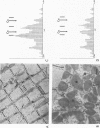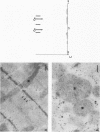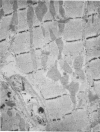Abstract
Reperfusion of ischemic myocardium is associated with increases in total myocardial calcium (Ca+2), which may influence the ultimate extent of ischemic damage as well as the development of arrhythmias. Since reperfusion is also associated with enhanced alpha-adrenergic responsivity, this study was performed to determine the potential interactions between alpha-adrenergic receptors and myocardial calcium during reperfusion. Cats were subjected to 35 min of left anterior descending coronary artery occlusion and 10 min of reperfusion. Total myocardial calcium was measured by atomic absorption spectrometry. Intracellular calcium was calculated from measurements of extracellular space [( 3H]inulin). In control animals with reperfusion, total calcium increased from 0.32 +/- 0.03 to 0.65 +/- 0.05 mmol/100 g dry tissue (P less than 0.0001), while intracellular calcium increased from 0.15 +/- 0.03 to 0.40 +/- 0.05 mmol/100 g dry tissue (P less than 0.001). Pretreatment with the alpha-adrenergic blocking agents phentolamine or prazosin prevented the increase in total and intracellular calcium. Phentolamine and the aqueous soluble alpha 1-adrenergic antagonist BE-2254 administered as late as 2 min before reperfusion similarly attenuated the increase in tissue calcium. Although administration of BE-2254 2 min before reperfusion failed to block the reperfusion-induced increase in extracellular space, the increase in calculated intracellular calcium was prevented. beta-Adrenergic blockade with propranolol partially attenuated but did not prevent an increase in total tissue calcium. Labetalol, a combined alpha- and beta-adrenergic blocking agent completely blocked the increase in tissue calcium during reperfusion. Additional experiments performed after 70 min of ischemia with reperfusion demonstrated a 49% attenuation of the increase in tissue calcium with alpha-adrenergic blockade. Electron microscopy with pyroantimonate and x-ray microprobe analysis demonstrated a large increase in calcium precipitate in mitochondria after reperfusion in untreated animals. Though alpha-adrenergic blockade prevented the calcium deposition in mitochondria, other criteria of ischemia persisted. Thus, alpha-adrenergic blockade specifically prevents the increase in intracellular calcium during reperfusion in reversibly injured tissue, independent of alterations in extracellular space and tissue water.
Full text
PDF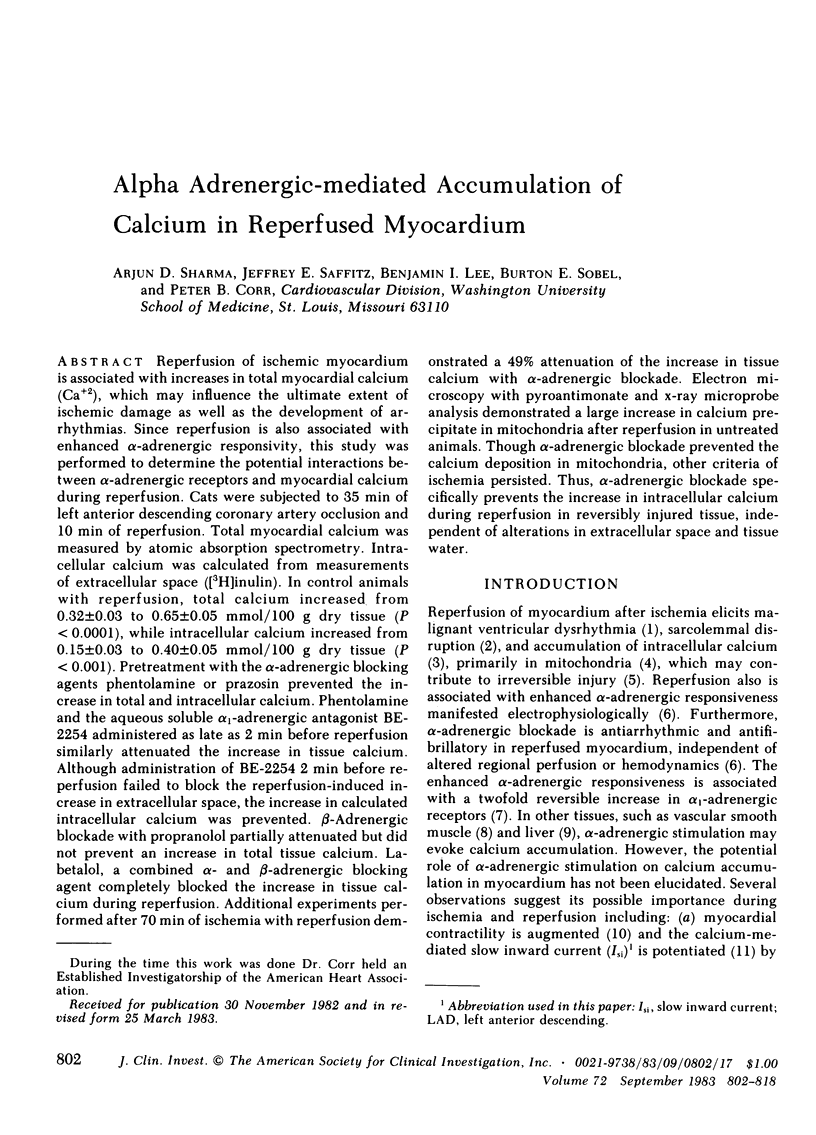
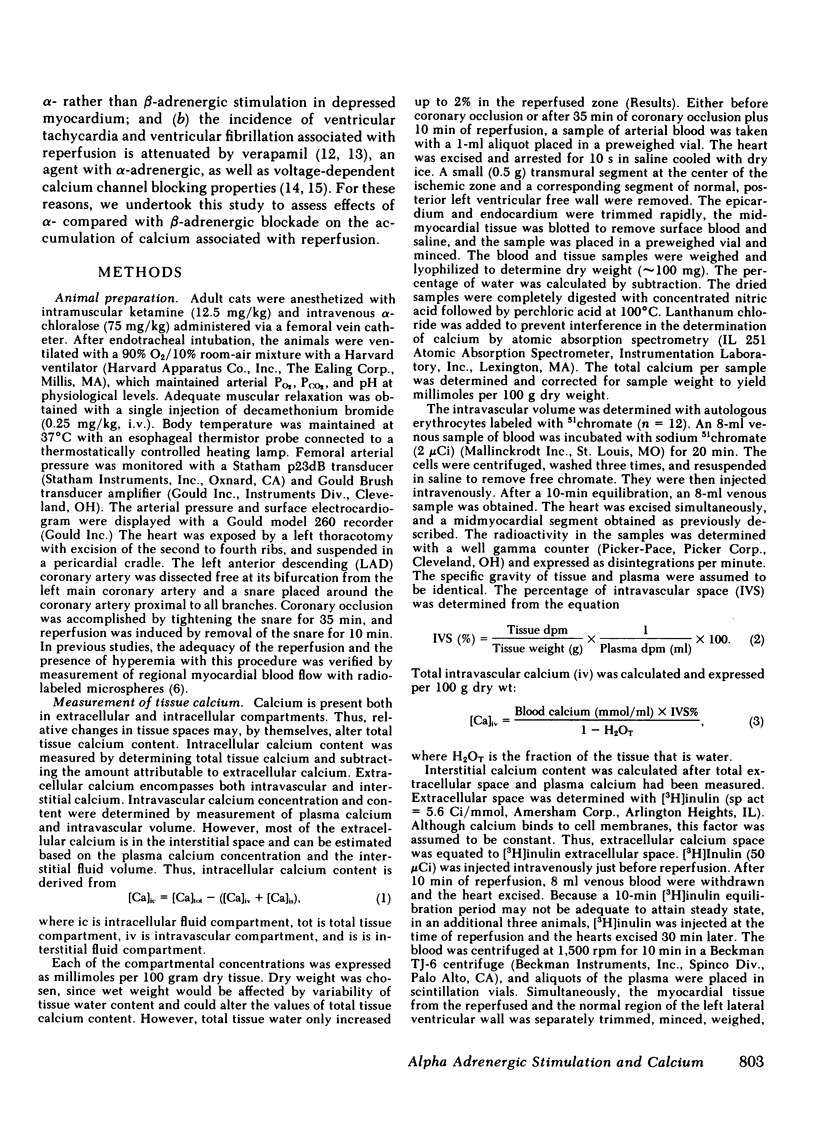
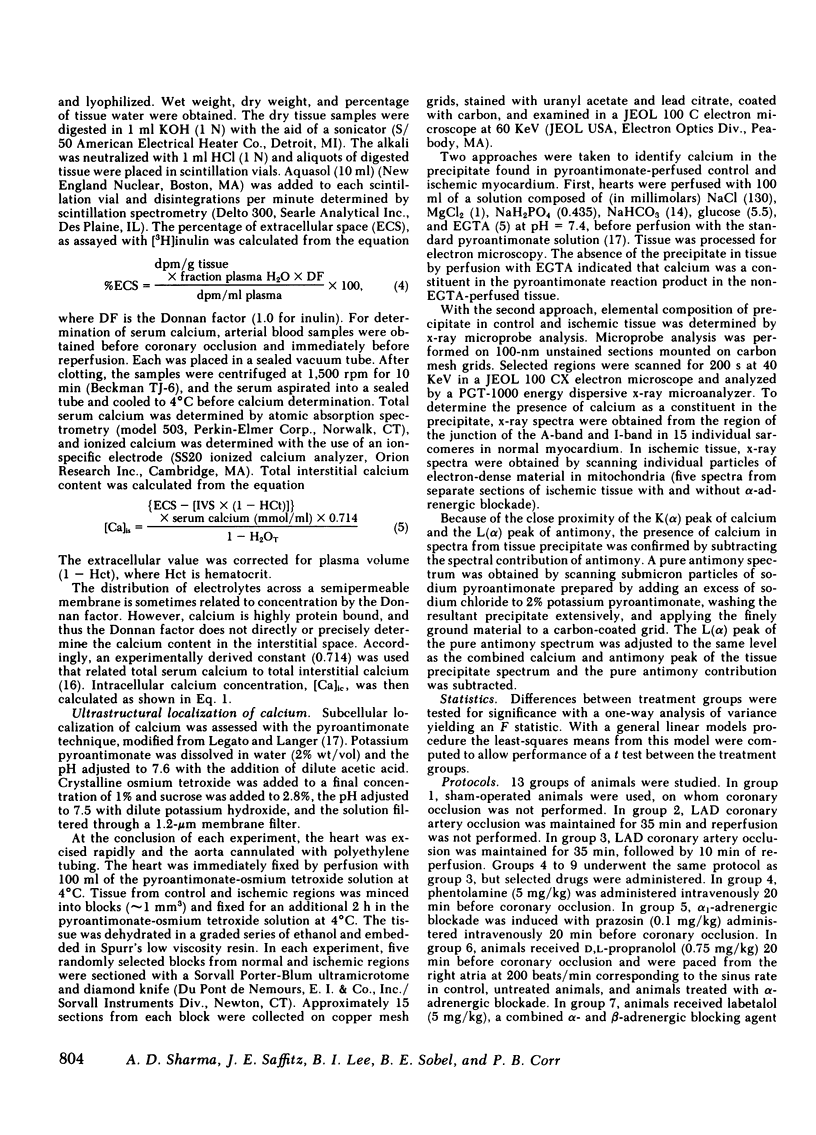
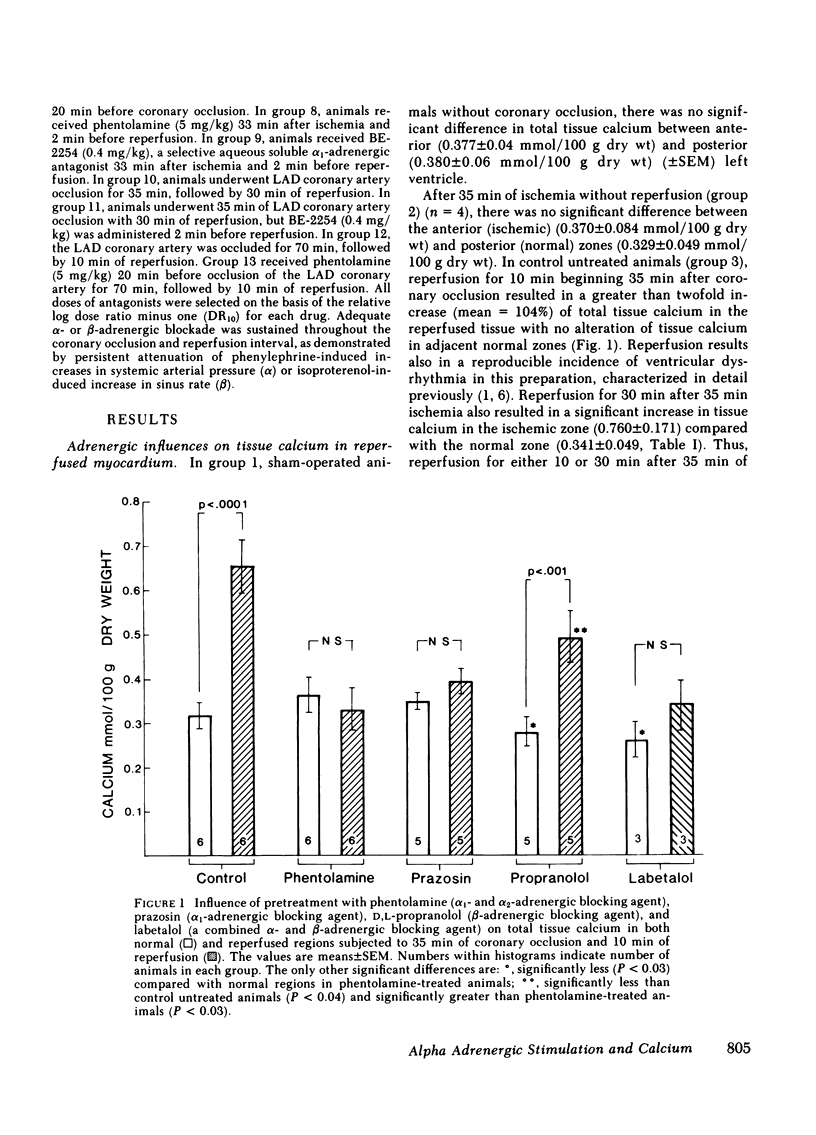

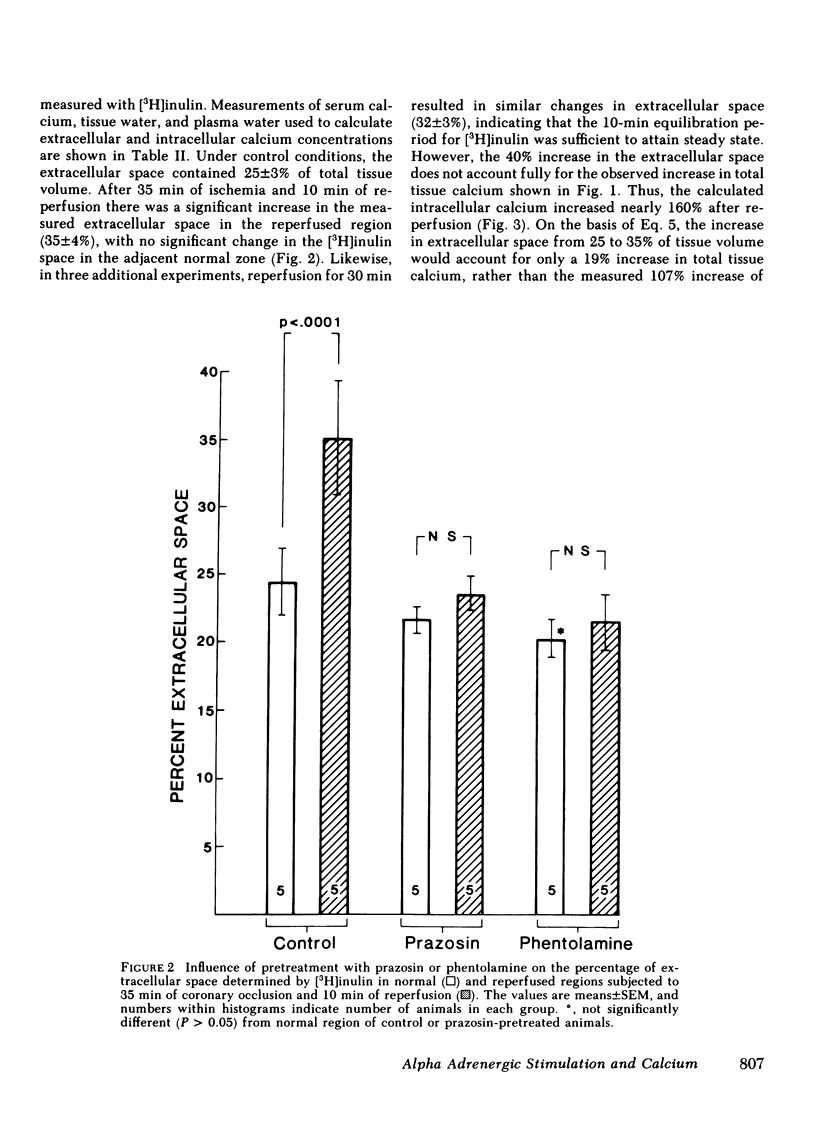

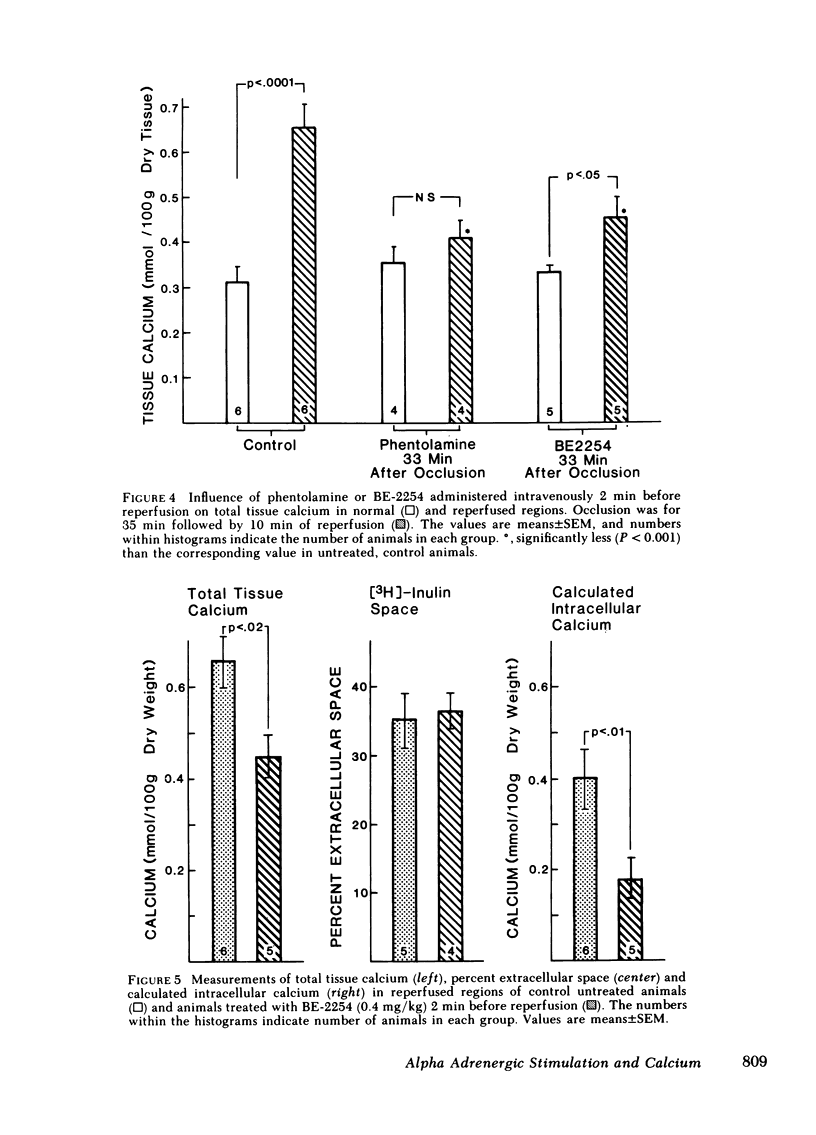
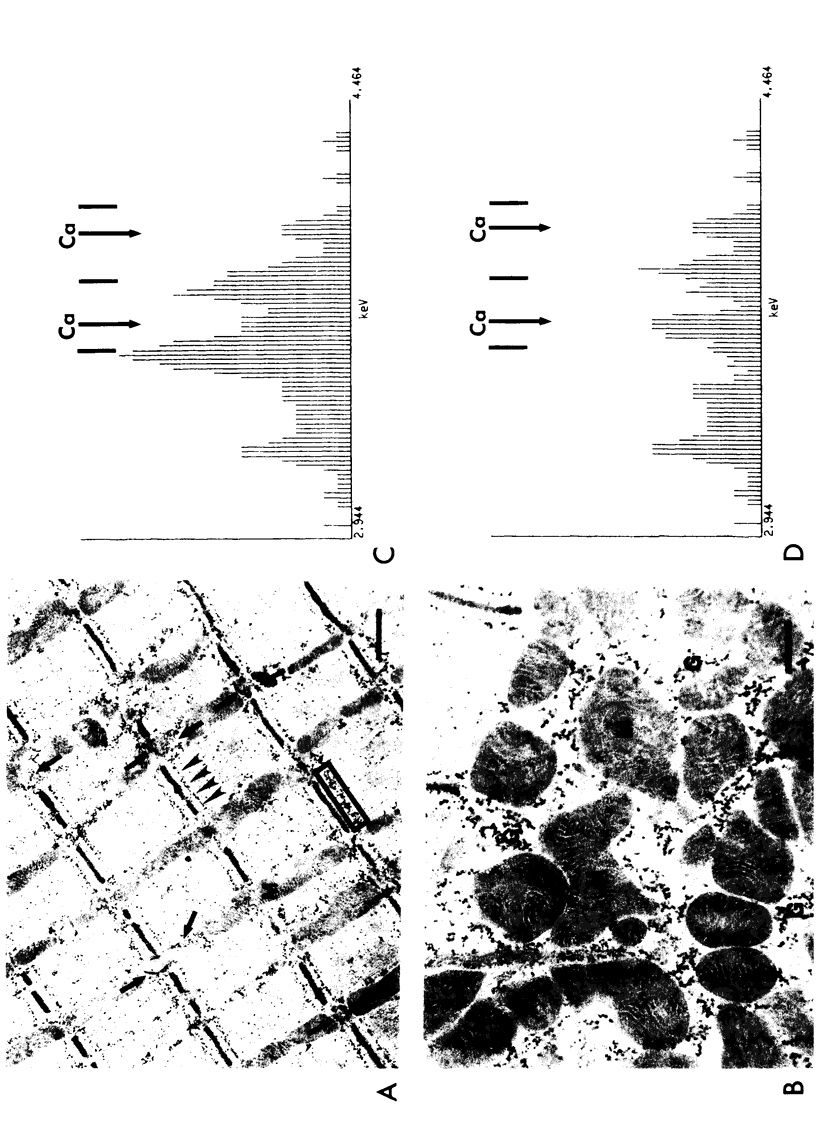

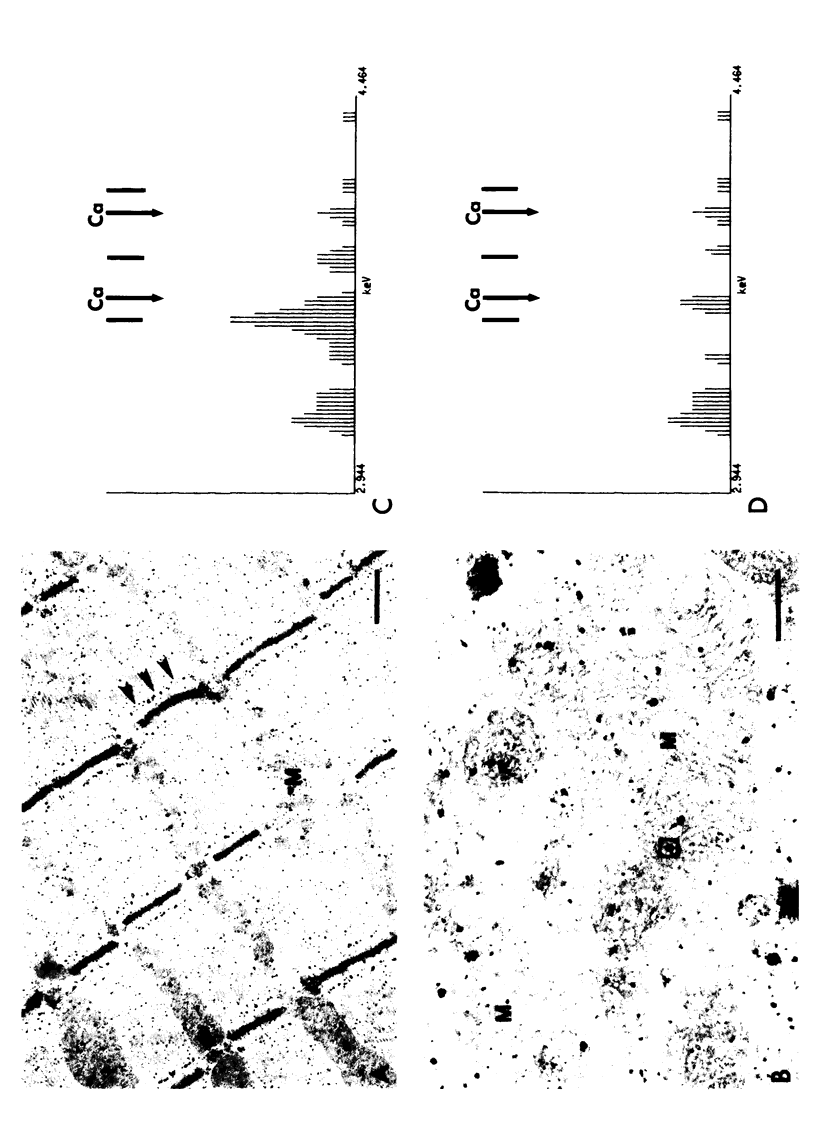
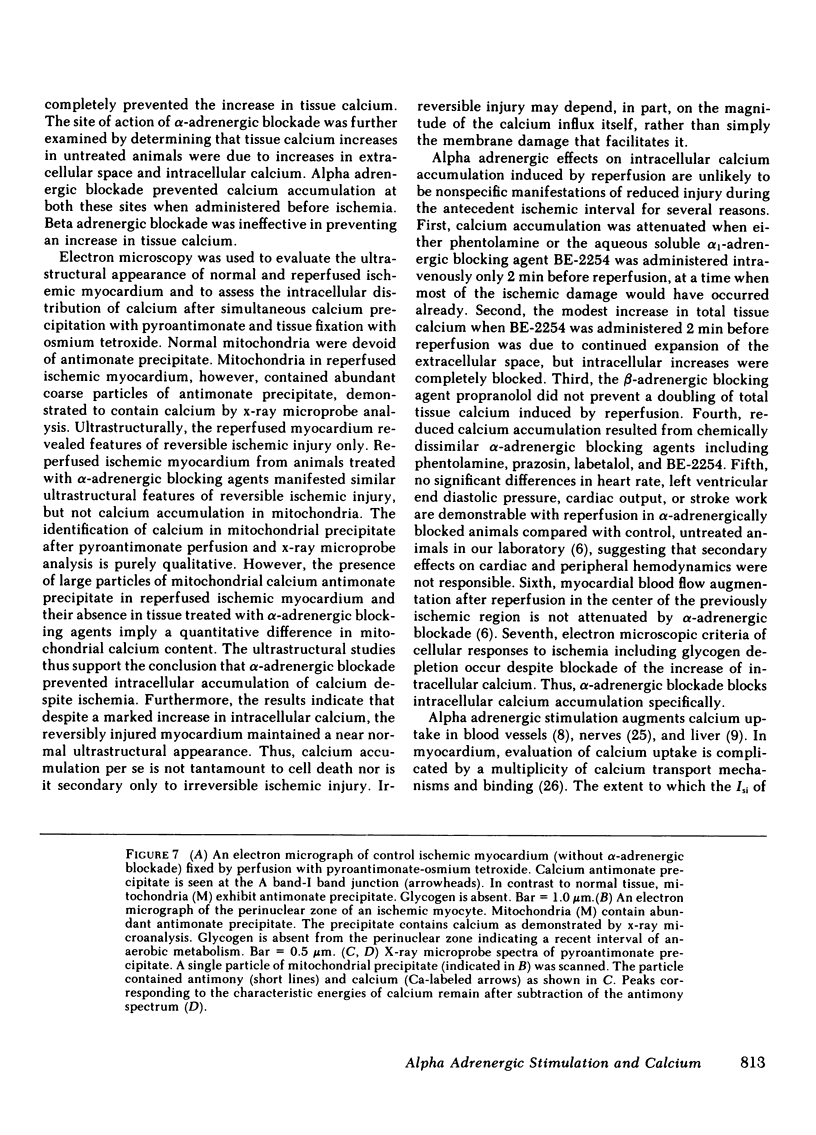
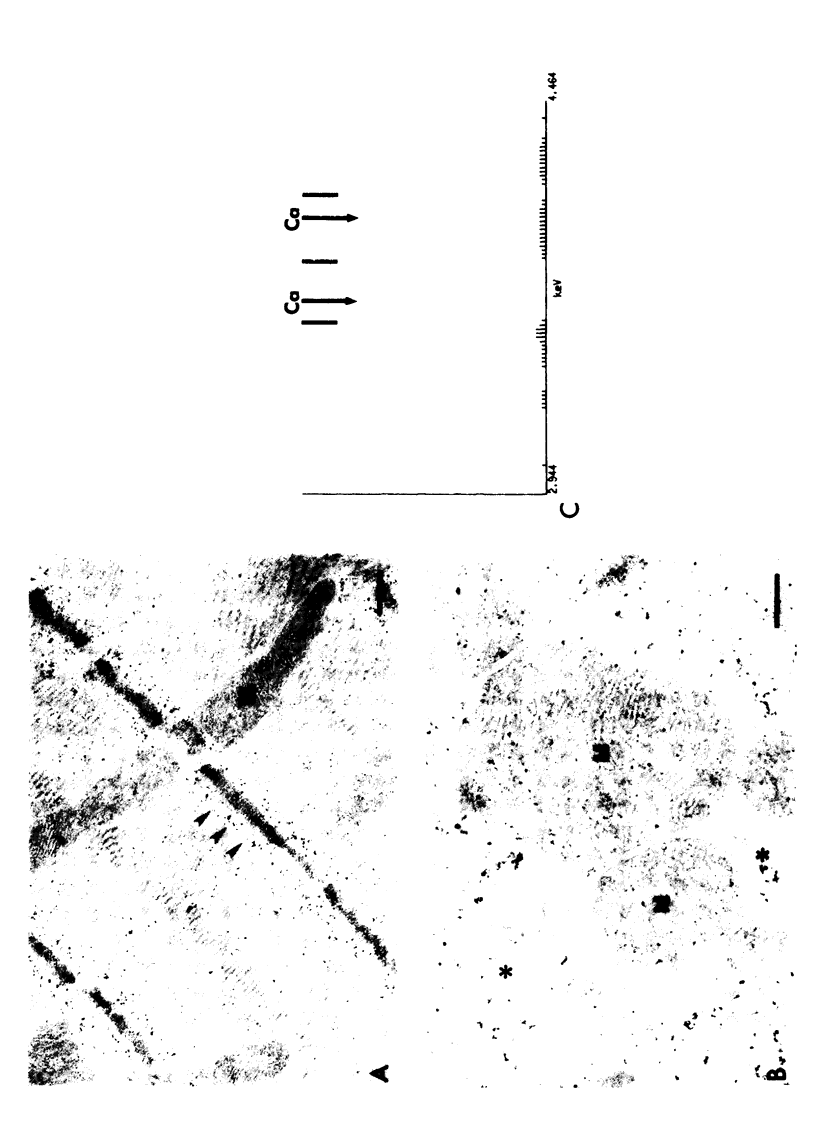
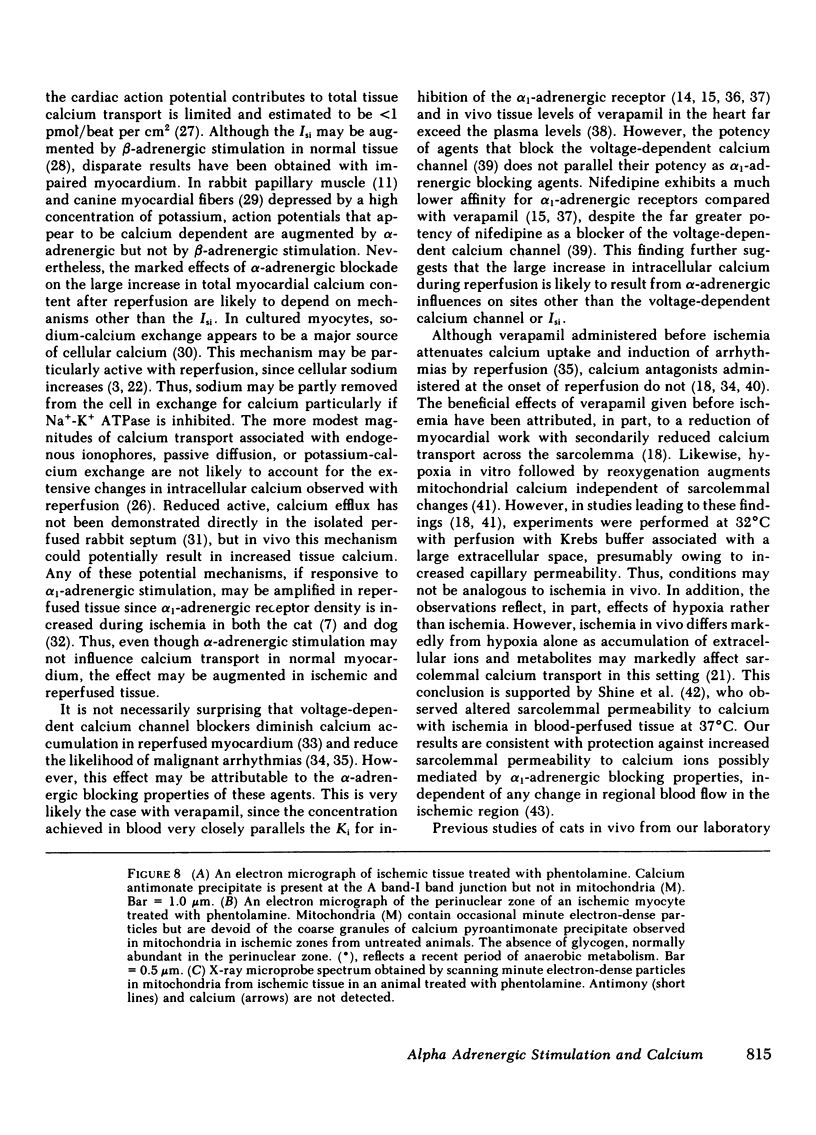
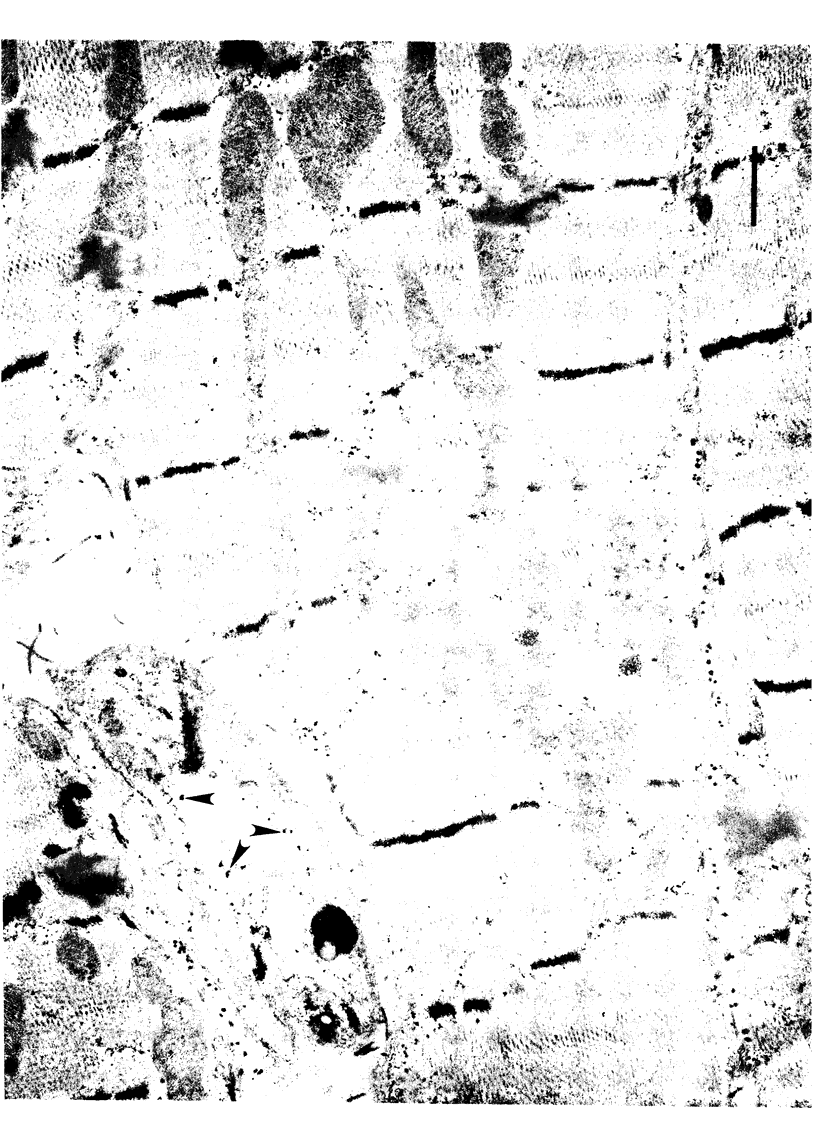

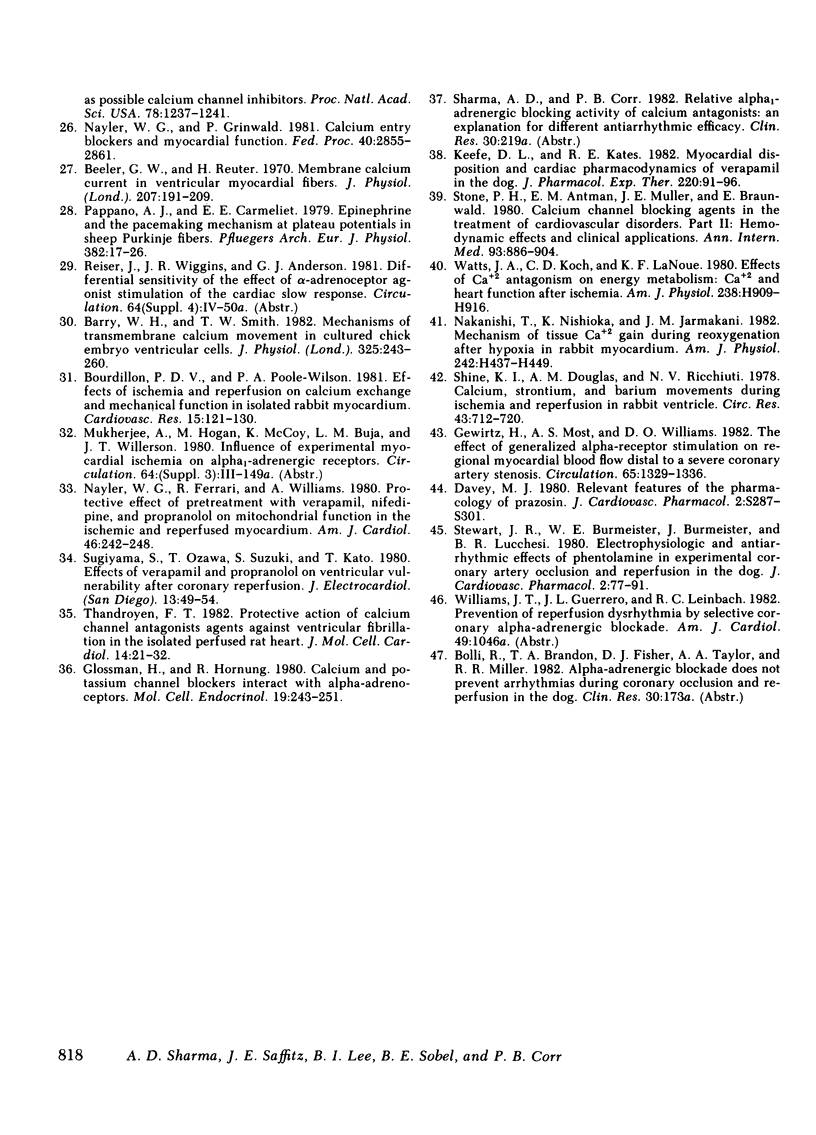
Images in this article
Selected References
These references are in PubMed. This may not be the complete list of references from this article.
- Barry W. H., Smith T. W. Mechanisms of transmembrane calcium movement in cultured chick embryo ventricular cells. J Physiol. 1982 Apr;325:243–260. doi: 10.1113/jphysiol.1982.sp014148. [DOI] [PMC free article] [PubMed] [Google Scholar]
- Beeler G. W., Jr, Reuter H. Membrane calcium current in ventricular myocardial fibres. J Physiol. 1970 Mar;207(1):191–209. doi: 10.1113/jphysiol.1970.sp009056. [DOI] [PMC free article] [PubMed] [Google Scholar]
- Bourdillon P. D., Poole-Wilson P. A. Effects of ischaemia and reperfusion on calcium exchange and mechanical function in isolated rabbit myocardium. Cardiovasc Res. 1981 Mar;15(3):121–130. doi: 10.1093/cvr/15.3.121. [DOI] [PubMed] [Google Scholar]
- Bourdillon P. D., Poole-Wilson P. A. The effects of verapamil, quiescence, and cardioplegia on calcium exchange and mechanical function in ischemic rabbit myocardium. Circ Res. 1982 Mar;50(3):360–368. doi: 10.1161/01.res.50.3.360. [DOI] [PubMed] [Google Scholar]
- Brooks W. W., Verrier R. L., Lown B. Protective effect of verapamil on vulnerability to ventricular fibrillation during myocardial ischaemia and reperfusion. Cardiovasc Res. 1980 May;14(5):295–302. doi: 10.1093/cvr/14.5.295. [DOI] [PubMed] [Google Scholar]
- Corr P. B., Lee B. I., Sobel B. E. Electrophysiological and biochemical derangements in ischemic myocardium: interactions involving the cell membrane. Acta Med Scand Suppl. 1981;651:59–69. doi: 10.1111/j.0954-6820.1981.tb03633.x. [DOI] [PubMed] [Google Scholar]
- Corr P. B., Shayman J. A., Kramer J. B., Kipnis R. J. Increased alpha-adrenergic receptors in ischemic cat myocardium. A potential mediator of electrophysiological derangements. J Clin Invest. 1981 Apr;67(4):1232–1236. doi: 10.1172/JCI110139. [DOI] [PMC free article] [PubMed] [Google Scholar]
- Cranefield P. F. Action potentials, afterpotentials, and arrhythmias. Circ Res. 1977 Oct;41(4):415–423. doi: 10.1161/01.res.41.4.415. [DOI] [PubMed] [Google Scholar]
- Engel G., Hoyer D. [125I]BE 2254, a new high affinity radioligand for alpha 1-adrenoceptors. Eur J Pharmacol. 1981 Jul 17;73(2-3):221–224. doi: 10.1016/0014-2999(81)90095-9. [DOI] [PubMed] [Google Scholar]
- Exton J. H. Molecular mechanisms involved in alpha-adrenergic responses. Mol Cell Endocrinol. 1981 Sep;23(3):233–264. doi: 10.1016/0303-7207(81)90123-4. [DOI] [PubMed] [Google Scholar]
- Gewirtz H., Most A. S., Williams D. O. The effect of generalized alpha-receptor stimulation on regional myocardial blood flow distal to a severe coronary artery stenosis. Circulation. 1982 Jun;65(7):1329–1336. doi: 10.1161/01.cir.65.7.1329. [DOI] [PubMed] [Google Scholar]
- Glossmann H., Hornung R. Calcium- and potassium-channel blockers interact with alpha-adrenoceptors. Mol Cell Endocrinol. 1980 Sep;19(3):243–251. doi: 10.1016/0303-7207(80)90054-4. [DOI] [PubMed] [Google Scholar]
- Godfraind T. Calcium exchange in vascular smooth muscle, action of noradrenaline and lanthanum. J Physiol. 1976 Aug;260(1):21–35. doi: 10.1113/jphysiol.1976.sp011501. [DOI] [PMC free article] [PubMed] [Google Scholar]
- Hearse D. J. Reperfusion of the ischemic myocardium. J Mol Cell Cardiol. 1977 Aug;9(8):605–616. doi: 10.1016/s0022-2828(77)80357-x. [DOI] [PubMed] [Google Scholar]
- Henry P. D., Schuchleib R., Davis J., Weiss E. S., Sobel B. E. Myocardial contracture and accumulation of mitochondrial calcium in ischemic rabbit heart. Am J Physiol. 1977 Dec;233(6):H677–H684. doi: 10.1152/ajpheart.1977.233.6.H677. [DOI] [PubMed] [Google Scholar]
- Karliner J. S., Motulsky H. J., Dunlap J., Brown J. H., Insel P. A. Verapamil competitively inhibits alpha 1-adrenergic and muscarinic but not beta-adrenergic receptors in rat myocardium. J Cardiovasc Pharmacol. 1982 May-Jun;4(3):515–520. doi: 10.1097/00005344-198205000-00025. [DOI] [PubMed] [Google Scholar]
- Keefe D. L., Kates R. E. Myocardial disposition and cardiac pharmacodynamics of verapamil in the dog. J Pharmacol Exp Ther. 1982 Jan;220(1):91–96. [PubMed] [Google Scholar]
- Kloner R. A., Ganote C. E., Whalen D. A., Jr, Jennings R. B. Effect of a transient period of ischemia on myocardial cells. II. Fine structure during the first few minutes of reflow. Am J Pathol. 1974 Mar;74(3):399–422. [PMC free article] [PubMed] [Google Scholar]
- Legato M. J., Langer G. A. The subcellular localization of calcium ion in mammalian myocardium. J Cell Biol. 1969 May;41(2):401–423. doi: 10.1083/jcb.41.2.401. [DOI] [PMC free article] [PubMed] [Google Scholar]
- MANERY J. F. Water and electrolyte metabolism. Physiol Rev. 1954 Apr;34(2):334–417. doi: 10.1152/physrev.1954.34.2.334. [DOI] [PubMed] [Google Scholar]
- Miura Y., Inui J., Imamura H. Alpha-adrenoceptor-mediated restoration of calcium-dependent potential in the partially depolarized rabbit papillary muscle. Naunyn Schmiedebergs Arch Pharmacol. 1978 Jan-Feb;301(3):201–205. doi: 10.1007/BF00507038. [DOI] [PubMed] [Google Scholar]
- Nakanishi T., Nishioka K., Jarmakani J. M. Mechanism of tissue Ca2+ gain during reoxygenation after hypoxia in rabbit myocardium. Am J Physiol. 1982 Mar;242(3):H437–H449. doi: 10.1152/ajpheart.1982.242.3.H437. [DOI] [PubMed] [Google Scholar]
- Nayler W. G., Ferrari R., Williams A. Protective effect of pretreatment with verapamil, nifedipine and propranolol on mitochondrial function in the ischemic and reperfused myocardium. Am J Cardiol. 1980 Aug;46(2):242–248. doi: 10.1016/0002-9149(80)90064-8. [DOI] [PubMed] [Google Scholar]
- Nayler W. G., Grinwald P. Calcium entry blockers and myocardial function. Fed Proc. 1981 Dec;40(14):2855–2861. [PubMed] [Google Scholar]
- Nayler W. G., Thompson J. E., Jarrott B. The interaction of calcium antagonists (slow channel blockers) with myocardial alpha adrenoceptors. J Mol Cell Cardiol. 1982 Mar;14(3):185–188. doi: 10.1016/0022-2828(82)90118-3. [DOI] [PubMed] [Google Scholar]
- Pappano A. J., Carmeliet E. E. Epinephrine and the pacemaking mechanism at plateau potentials in sheep cardiac Purkinje fibers. Pflugers Arch. 1979 Oct;382(1):17–26. doi: 10.1007/BF00585899. [DOI] [PubMed] [Google Scholar]
- Penkoske P. A., Sobel B. E., Corr P. B. Disparate electrophysiological alterations accompanying dysrhythmia due to coronary occlusion and reperfusion in the cat. Circulation. 1978 Dec;58(6):1023–1035. doi: 10.1161/01.cir.58.6.1023. [DOI] [PubMed] [Google Scholar]
- Reimer K. A., Lowe J. E., Jennings R. B. Effect of the calcium antagonist verapamil on necrosis following temporary coronary artery occlusion in dogs. Circulation. 1977 Apr;55(4):581–587. doi: 10.1161/01.cir.55.4.581. [DOI] [PubMed] [Google Scholar]
- Ribeiro L. G., Brandon T. A., Debauche T. L., Maroko P. R., Miller R. R. Antiarrhythmic and hemodynamic effects of calcium channel blocking agents during coronary arterial reperfusion. Comparative effects of verapamil and nifedipine. Am J Cardiol. 1981 Jul;48(1):69–74. doi: 10.1016/0002-9149(81)90573-7. [DOI] [PubMed] [Google Scholar]
- Shen A. C., Jennings R. B. Myocardial calcium and magnesium in acute ischemic injury. Am J Pathol. 1972 Jun;67(3):417–440. [PMC free article] [PubMed] [Google Scholar]
- Sheridan D. J., Penkoske P. A., Sobel B. E., Corr P. B. Alpha adrenergic contributions to dysrhythmia during myocardial ischemia and reperfusion in cats. J Clin Invest. 1980 Jan;65(1):161–171. doi: 10.1172/JCI109647. [DOI] [PMC free article] [PubMed] [Google Scholar]
- Shine K. I., Douglas A. M., Ricchiuti N. V. Calcium, strontium, and barium movements during ischemia and reperfusion in rabbit ventricle. Implications for myocardial preservation. Circ Res. 1978 Nov;43(5):712–720. doi: 10.1161/01.res.43.5.712. [DOI] [PubMed] [Google Scholar]
- Stewart J. R., Burmeister W. E., Burmeister J., Lucchesi B. R. Electrophysiologic and antiarrhythmic effects of phentolamine in experimental coronary artery occlusion and reperfusion in the dog. J Cardiovasc Pharmacol. 1980 Jan-Feb;2(1):77–91. doi: 10.1097/00005344-198001000-00009. [DOI] [PubMed] [Google Scholar]
- Stone P. H., Antman E. M., Muller J. E., Braunwald E. Calcium channel blocking agents in the treatment of cardiovascular disorders. Part II: Hemodynamic effects and clinical applications. Ann Intern Med. 1980 Dec;93(6):886–904. doi: 10.7326/0003-4819-93-6-886. [DOI] [PubMed] [Google Scholar]
- Sugiyama S., Ozawa T., Suzuki S., Kato T. Effects of verapamil and propranolol on ventricular vulnerability after coronary reperfusion. J Electrocardiol. 1980;13(1):49–54. doi: 10.1016/s0022-0736(80)80009-4. [DOI] [PubMed] [Google Scholar]
- Takeyama Y., Ozawa K., Katagiri T. Studies on the subcellular localization of electrolytes in normal and infarcted canine myocardium. With special reference to calcium ion. Jpn Heart J. 1980 Nov;21(6):859–872. doi: 10.1536/ihj.21.859. [DOI] [PubMed] [Google Scholar]
- Thandroyen F. T. Protective action of calcium channel antagonist agents against ventricular fibrillation in the isolated perfused rat heart. J Mol Cell Cardiol. 1982 Jan;14(1):21–32. doi: 10.1016/0022-2828(82)90102-x. [DOI] [PubMed] [Google Scholar]
- Watts J. A., Koch C. D., LaNoue K. F. Effects of Ca2+ antagonism on energy metabolism: Ca2+ and heart function after ischemia. Am J Physiol. 1980 Jun;238(6):H909–H916. doi: 10.1152/ajpheart.1980.238.6.H909. [DOI] [PubMed] [Google Scholar]
- Whalen D. A., Jr, Hamilton D. G., Ganote C. E., Jennings R. B. Effect of a transient period of ischemia on myocardial cells. I. Effects on cell volume regulation. Am J Pathol. 1974 Mar;74(3):381–397. [PMC free article] [PubMed] [Google Scholar]



